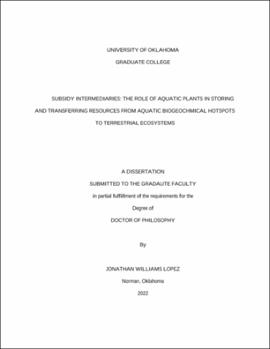| dc.description.abstract | The roles mobile animals and abiotic processes play as vectors for resource transfers between ecosystems (subsidies) are well-studied. Trophic interactions between mobile animals and their food sources often convey subsidies across ecosystem boundaries. However, the quality and quantity of such ecological subsidies may be altered by indirect interactions between seemingly unconnected taxa. For example, resources from animals with limited mobility may be transported across ecosystem boundaries through intermediate taxa. In freshwater ecosystems in North America, freshwater mussels (Bivalvia: Unionoida) can have major biogeochemical impacts, including the creation of nutrient cycling hotspots of biologically necessary elements (bioelements) such as nitrogen (N) and phosphorus (P). Such hotspots are also inhabited by dense beds of aquatic macrophytes, which may mediate transfers of aquatic-derived nutrients from immobile mussel aggregations to terrestrial ecosystems when macrophytes are consumed by terrestrial herbivores. For my dissertation research I studied the nutrient and mineral dynamics that drive multi-step aquatic-to-terrestrial resource subsidies from mussel-generated biogeochemical hotspots, to emergent aquatic macrophytes, and to terrestrial herbivores.
In Chapter One, I conducted a mesocosm experiment to test whether mussel-generated biogeochemical hotspots increase growth or N and P content in the macrophyte Justicia americana. J. americana biomass production increased and belowground biomass allocation changed with increasing mussel density. At high mussel density, water column phosphorus increased and carbon (C):P ratios in J. americana tissues decreased. I also deployed motion-sensing cameras to explore herbivory on J. americana growing along the margins of the Kiamichi River, Oklahoma, USA, and documented feeding by large mammals (Odocoileus virginianus, Sus scrofa, and Bos taurus).
In Chapter Two, I used an ionomic approach to simultaneously explore whether freshwater mussel density covaries with the cycling of 10 major bioelements (Ca, Cu, Fe, K, Mn, Na, Mg, P, S and Zn) across a naturally occurring mussel density gradient in the US Interior Highlands. I sampled this suite of bioelements in three different locations within the stream ecosystem: the water column, riverine gravel bar subsurface, and J. americana. In streams, higher mussel density was associated with elevated levels of calcium in gravel bars and J. americana. There were also contrasting associations of mussels with lower levels of trace elements in the gravel bar subsurface (Fe, Mn) and higher levels in J. americana (Fe, Cu, Zn). This effect was mediated by sediment size and may indicate these macrophytes preferentially adsorb certain bioelements when they are scarce.
In Chapter Three, I built on the findings of Chapter One by conducting field studies testing (1) whether the density and the N and P content of J. americana increase in response to mussel density under natural conditions, and (2) whether terrestrial herbivores preferentially consume macrophytes from mussel-generated hotspots, promoting aquatic-to-terrestrial subsidies. Mussel density did not have strong effects on N and P concentrations in sediment porewater or on macrophyte density, but N isotopes in J. americana leaves indicated assimilation of mussel-derived nutrients. Further analysis of the data from the motion-sensing camera surveys conducted in Chapter One indicated that terrestrial herbivores fed more frequently at mussel-generated hotspots. C and N concentrations and isotopes in white-tailed deer (Odocoileus virginianus) feces suggested that deer receive nutritional benefits from macrophyte consumption and convey nutrients from J. americana into terrestrial ecosystems.
Thus, biogeochemical hotspots generated by aquatic animal aggregations can promote macrophyte production that subsequently is transferred by herbivores to nearby terrestrial habitats that are relatively nutrient limited. Macrophytes adsorb mussel-derived nutrients, and mussel beds are associated with elevated calcium and trace element concentrations in macrophyte tissues. Because mussel-generated hotspots appeared to have stronger effects on calcium and mineral bioelements than N and P, my findings indicate that elevated mineral content in macrophytes may drive increases in terrestrial mammal herbivory. Calcium and other minerals and trace elements such as iron have been proposed as key drivers of ecological processes. Such mineral elements may be important determinants of animal-driven ecological subsidies because they are relatively scarce in the environment and in plants, but essential to animal physiology. More broadly, my research suggests that reductions in aquatic animal biomass may have bottom-up impacts that indirectly affect terrestrial ecosystems via plant-animal interactions bridging ecosystem boundaries. | en_US |
